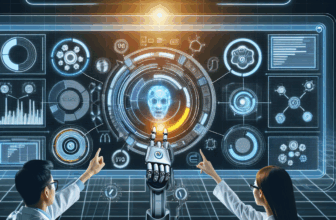Revolutionizing Web Development: The Benefits of AI-Powered Automated Website Design
Table of Contents
- 1. Introduction to AI in Web Development
- 2. How AI Enhances Automated Website Design
- 3. Key Technologies Driving AI-Powered Design
- 4. Real-Life Examples and Case Studies
- 5. Challenges and Limitations of AI in Web Development
- 6. Future Trends in AI-Powered Website Design
- 7. Frequently Asked Questions (FAQ)
- 8. Resources
- Conclusion
1. Introduction to AI in Web Development
In recent years, artificial intelligence (AI) has increasingly found applications in various industries, and web development is no exception. Automated website design powered by AI is revolutionizing how developers and businesses create and manage websites. With the ability to analyze data, predict user behavior, and generate design elements dynamically, AI is transforming a traditionally manual process into an efficient, scalable solution.
This section will explore the significance of AI in web development, examining how it can automate tedious tasks, provide deeper insights into user preferences, and streamline the overall design process.
2. How AI Enhances Automated Website Design
AI enhances automated website design by integrating advanced technologies that expedite processes and improve overall outcomes. This section discusses three critical areas where AI makes a significant impact.
2.1 Streamlining Design Processes
One of the most notable benefits of AI in web development is its ability to streamline design processes. Traditional website design often involves repetitive tasks, including wireframing, layout adjustments, and content optimization. AI tools today can automate several of these tasks, resulting in reduced workload for developers and designers.
AI-driven platforms enable users to input basic requirements, such as preferred colors, styles, and contents, and generate initial design layouts in minutes. For example, platforms like Wix and Bookmark utilize AI algorithms to create websites based on user preferences and requirements, drastically cutting down time and effort compared to traditional methods.
2.2 Personalization at Scale
AI’s data analysis capabilities allow for a level of personalization that traditional methods struggle to achieve. By utilizing machine learning algorithms, AI can analyze vast amounts of user data, including browsing habits, preferences, and demographic information, to create personalized user experiences.
This personalization extends to content generation, where AI tools can curate articles, images, and product suggestions based on user profiles, making websites more engaging and relevant. For instance, services like Netflix and Amazon utilize machine learning algorithms to recommend content, creating personalized user journeys that enhance satisfaction and retention.
2.3 Improved User Experience
Ultimately, AI-powered automated website design leads to an improved user experience. Leveraging AI, web developers can create adaptive interfaces that respond to user interactions and preferences. For instance, AI can optimize navigation elements based on user behavior patterns, ensuring that essential features are easily accessible to users.
Additionally, AI can improve loading times and overall performance by utilizing predictive loading techniques, further enhancing user satisfaction. All these advancements collectively result in websites that are not only visually appealing but also functional and user-centric.
3. Key Technologies Driving AI-Powered Design
The success of AI-powered website design relies on several key technologies, namely machine learning and natural language processing. This section outlines how these technologies contribute significantly to enhancing web development processes.
3.1 Machine Learning Algorithms
Machine learning (ML) is at the forefront of AI applications in web development. ML algorithms can analyze data and learn from patterns, enabling systems to improve functionality and accuracy over time. This capability allows AI-driven website design tools to adapt and refine their offerings based on user feedback and interactions.
AI can also segment users into specific categories, which allows for targeted marketing strategies and content curation unique to each user segment. As a result, businesses can achieve higher engagement rates and conversion metrics.
3.2 Natural Language Processing
Natural Language Processing (NLP) enables machines to understand, interpret, and respond to human language in a valuable way. In the context of AI-powered automated website design, NLP can facilitate content creation, chatbots, and communication functionalities.
NLP algorithms can assist in generating human-like text, automating customer interactions on websites, and providing valuable insights into user feedback. This technology allows for improved interaction quality, making website navigation and customer service more efficient.
4. Real-Life Examples and Case Studies
To illustrate the transformative impact of AI-powered automated website design, we can explore real-life case studies showcasing businesses that have embraced these technologies to significant effect.
One noteworthy example is the use of AI in e-commerce. Companies such as Shopify have integrated AI-driven tools that aid merchants in creating customized storefronts without needing extensive design knowledge. This accessibility enables more businesses to establish a web presence and compete effectively.
Another case to consider is the rise of platforms like Squarespace, which utilize AI to suggest improvements to existing websites and assist users in making informed design decisions.
5. Challenges and Limitations of AI in Web Development
Despite the advantages, several challenges and limitations accompany the adoption of AI in web development. This section will explore the prevalent challenges faced by developers and companies when integrating AI technologies.
- Data Privacy Concerns: With the utilization of user data comes the need for transparency and responsible handling of sensitive information. Businesses must prioritize compliance with regulations such as GDPR.
- Quality Control: Even AI-generated designs require oversight to ensure coherence and alignment with brand identity. The risk of automation leading to a lack of originality is a common concern.
- Implementation Challenges: Transitioning to AI-driven solutions can be challenging, particularly for smaller businesses with limited resources or technological infrastructure.
6. Future Trends in AI-Powered Website Design
As technology continues to evolve, several trends are emerging concerning the future of AI in web development. This section explores anticipated advancements and their potential implications.
One trend is the rising popularity of no-code platforms, which allow users to design and deploy websites without coding knowledge. Such platforms will increasingly incorporate AI to enhance user experience further.
Moreover, a significant focus on ethical AI practices will likely emerge, emphasizing transparency, accountability, and responsible data usage to ensure user trust and compliance with regulations.
7. Frequently Asked Questions (FAQ)
Q: What are the primary benefits of AI-powered automated website design?
A: The primary benefits include streamlined design processes, enhanced personalization, improved user experience, and the ability to analyze vast amounts of data for continual improvement.
Q: Are there any notable tools for AI-powered website design?
A: Yes, notable tools include Wix ADI, Bookmark, and Squarespace, each of which offers unique AI-driven functionalities to enhance web design.
Q: What challenges might I face when adopting AI in web development?
A: Challenges can include data privacy concerns, quality control issues, and potential implementation difficulties, particularly for smaller businesses.
8. Resources
| Source | Description | Link |
|---|---|---|
| Wix AI | AI-powered website builder. | Link |
| Bookmark | Automated site creation using AI. | Link |
| Shopify AI | AI tools for e-commerce design. | Link |
| Squarespace | Website building and hosting service with AI features. | Link |
| Natural Language Processing | Research on NLP technologies. | Link |
Conclusion
In conclusion, AI-powered automated website design represents a seismic shift in how businesses approach web development. By streamlining processes, enhancing personalization, and improving user experiences, AI technologies are revolutionizing design practices. While there are challenges to overcome, such as ensuring data privacy and maintaining quality control, the benefits are substantial.
As we look into the future, trends like no-code platforms and a focus on ethical AI practices will likely dominate the landscape of web development. For businesses and developers willing to embrace these technologies, the potential for growth and innovation is immense.
As a final note, this article is produced by A.I. and is in Beta Testing. The content herein reflects current trends and insights into AI's impact on web development.










